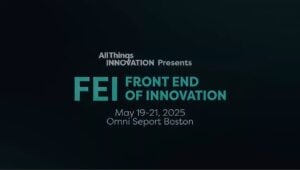Blending AI with Human Intelligence
There are many lessons that the innovation community can also learn from their market research peers. While there was much trepidation, and cautious optimism, at TMRE 2023 regarding AI, this past year saw a change in perspective as the community seemed encouraged and positive about this powerful market research tool and how it can amplify their efforts in insights, innovation and new product development. Embracing change in the industry or combating broader market forces such as inflation, harnessing AI with human oversight, and enhancing leadership skills were all prevalent themes.
The session, “How AI & Digital Transformation are Redefining Consumer Behavior,” served as an important reminder that the principle of “adapt or fall behind” is accelerating as AI grows in the marketplace and companies invest in digital transformation efforts to rapidly strive to keep pace. As we know, digital transformation is a key innovation imperative as well.
As always, the digital age is empowered by an evolving consumer. “Consumers are more informed, connected and digitally empowered than ever before,” says Katy Emerson, EVP, Customer Success at Suzy, who held the session along with her colleague, Mary Lois Smith, Senior Director, Market Research at Suzy.
While AI still needs a human touch, the technology is bringing immediacy and responsiveness to the market, creating a dynamic two-way relationship, noted Suzy’s executives. Consumer expectations and interactions are going beyond traditional models as they expect more customization and personalization in their alignment with brands today. For the innovation professional, it’s all about adaptation as they identify practical applications of AI while pinpointing consumer preferences.
Still, with the acknowledgement of AI’s advantages, there is the key of human oversight that’s needed, and to bring humanity and all its benefits to research and innovation. Knowing that humanity is first and foremost the priority, means knowing your consumer, their mindset and values. This in turn can be leveraged in innovation efforts with newly developed products and services.
The panel, “How to Keep Humanity at the Core of Market Research,” served as fuel for thinking that even in an age of advancing technology and data-driven insights, it’s crucial to remember the human element, especially through the lens of consumer insights.
Moderated by Casey Mohan, VP, Qualitative Insights & Strategy at CMB, the panel included Jessica Lilie, Vice President, Research, Insights and Analytics at Sutter Health; Teresa Correa-Pavlat, Consumer, Business, Insights & Analytics Lead, Brand & Incubator at Haleon; and Alan Moskowitz, Vice President of Consumer Insights at C Space.
Ultimately, market research, and through it the innovation initiatives that could result from insights collaboration, is still about “understanding the emotion of real people,” notes Moskowitz, who adds, “Market research needs to be human centered, intentional and prioritizing people.” Regardless of the tools used, such as AI, keeping the human first and our curiosity at the forefront will add value and brand relevancy to the insights and innovation mission.
Strengthening Brand Health for Innovation
While AI was a prevalent topic of sessions and conversations at TMRE 2024, there was also a healthy dose of other themes on the executive’s table. Highlighted at several sessions was the concept of brand health tracking. This could also benefit innovation efforts when it comes to brand and new product development.
This category seems to have been energized with the growth and advantages of AI and the introduction of new marketing tools, which has made brand health tracking easier and less of a chore, measured by more recognizable key performance indicators with the result that more dynamic action can be taken.
In the session, “Tracking Mental Availability & Advantages with Organic Valley,” the food brand teamed up with Quantilope to introduce a new approach to dynamic brand health tracking based on recent work from Professor Jenni Romaniuk and the Ehrenberg-Bass Institute. This new approach focuses on category entry points, mental availability, and mental advantages. The session was held by Organic Valley’s Senior Director of Consumer Strategy, Tripp Hughes, and Quantilope’s Senior Solutions Consultant, Gianna Saladino.
In the case study, Organic Valley was able to monitor its brands and the product categories as a whole and understand how the brands grow, how to measure brand health, and how to increase the mental availability of the brands for consumers. Overall, the new brand tracking gave Organic Valley new frameworks and new avenues to build wider, fresher networks, increase category entry points and increase mental availability. This further gave the brand more actionable insights, plus ways to evaluate advertising and measure quality of marketing, all key points to leverage innovation and research and development efforts as well.
Through the brand health tracking, Organic Valley was able to compare different entry categories, such as milk versus cheese, breakfast versus snacks and taste versus experience, for example.
“It’s really a new way to think of the consumer and build strategy,” says Hughes. He adds, “Unlike traditional brand tracking, we were able to play and compare across different categories, and better identify core consumer drivers. You have to understand both your higher and lower level brand drivers. These metrics can impact decision makers, as well as marketing, brand activation, innovation and identify areas of growth.”
Other sessions at TMRE that focused on brand tracking tactics included, “Just-Right Brand Tracking for Bob’s Discount Furniture,” with Brendan Baby, VP Insights and Analytics at Bob’s Discount Furniture, and Lauren Deraleau, Head of Research at Glass. They discussed how to build a strong brand tracking program—one that was robust, reliable, tailored to their specific business and needs as well as affordable.
“We were building the insights capability and looking at how to integrate and activate a brand tracking program,” says Baby, pointing out that it has to deliver value, be customizable and ultimately deliver business impact through a framework for brand measurement.
An additional session, “Using Discover’s Brand Health Tracker to Expand Brand Image and Drive Growth,” also explored the topic and how new processes can take you beyond just tracking to drive marketing, strategic and foundational improvements, and integrate multiple products such as what innovation might provide. The session was held by Paula Chona, Senior Principal, Consumer Insights at Discover Financial Services.
“Brand health tracking can identify new opportunities and can guide future product strategy, as well as be part of a multi-pronged research approach,” notes Chona. “An enhanced brand health tracking program really sparked a mixed methodology of quant, qual and vendor measurements—all these tools working together.”
Igniting Innovation Through Enhanced Qual Research
Speaking of qualitative research, several sessions in part focused on how qualitative methods, which are often viewed as a bit slower moving and cumbersome, are igniting a renewal as researchers leverage AI to enhance this key research tool for both vendors and client-side parties.
In the presentation, “Fruit of the Loom Case Study: Spinning Qual Feedback into Insights Gold,” Chad Holleman, Senior Director of Consumer Insights at Fruit of the Loom, discussed a new program taking place in partnership with Canvs AI.
While qualitative feedback is a rich source for empathetic consumer insights, the inefficiency and complexity of analysis lead many research teams to approach qual with trepidation. Holleman shared how AI is being stitched into the fabric of consumer insights at Fruit of the Loom, automating mundane tasks and empowering focus on weaving compelling, evidence-based stories. Indeed, Holleman points out, AI-programs like the one through Canvs can help with text analysis, enhance empathy, support storytelling and ramp up speed of insights to impact the business, including in innovation of new products.
“It really accelerated the business impact and empowered us to take qual to the next level,” says Holleman. “The program elevated the customer voice and increased the impact of our insights. AI investments will make us that much better, strengthening and improving partnerships and collaborations, as well as democratize the data across the organization.”
In a similar vein, the session, “Blending Brains and Bots: Strategically Leveraging AI and Human Insights in Qualitative Research,” presented by Kendall Nash, SVP at Burke, also looked at how qual is being energized by AI, with some human insights and oversight in the mix as well.
While using AI to conduct and speed qualitative interviews, both in text and voice, is still an imperfect science, progress is being made on many fronts. Nash points out, for example, that AI in qual can support the screening upfront, synthesize a range of tools and help with the data collection, assessment criteria and interviews.
Optimum qual research is often subjective, an honest and authentic conversation and discussion, and often needs to be put into context, identify nuances and understand relevant client goals. This is really where human skills come into play, says Nash, whereby we can gauge credibility or notice incongruencies in the narrative, developing deeper and authentic discussions.
Still, as Nash compared AI to human insights, it remains clear that a combination of both AI and human insights can help enhance qual research and enable progress on both the insights and innovation fronts.
AI-moderated versus human-moderated qualitative interviews may still present some advantages and disadvantages, but AI is quickly stepping up its game and skill sets. However, the qualitative researcher must provide contextual guidance, and often must adjust their approach to each individual in the study. Bots may not replace human moderators quite yet, Nash points out, but AI and human insights together can perhaps push qualitative research to new heights in terms of efficiency and storytelling.
With much of the conference focusing on both AI and human intelligence, as the insights community came together at TMRE to learn, converse and celebrate, the market research industry showed excitement, an embrace of change and resilience—and perhaps indicated that the full story of AI and HI has yet to be written. This should also bode well for innovation experts at the top of their field, as they look to leverage this new age of analytics in their research and development efforts.
Editor’s Note: A version of this story first appeared on All Things Insights. The next TMRE will take place October 28-30, 2025, at the Paris Las Vegas Hotel in Las Vegas, NV.
Contributor
-

Matthew Kramer is the Digital Editor for All Things Insights & All Things Innovation. He has over 20 years of experience working in publishing and media companies, on a variety of business-to-business publications, websites and trade shows.
View all posts































































































































